Fashion Style of the Gibionites of the 21st Century
What women wore: the fabrics

A immature woman wearing her dowry
Article of clothing in aboriginal Israel was usually
- woolen fabric, either dyed or in its natural color, or
- linen made from a plant chosen flax.
Wool was easier to work with, and it took dyes better. Information technology was also waterproof to some extent, giving amend protection confronting the atmospheric condition. Linen was effectively and more expensive.
Who made the dress?
Women were largely responsible for production of clothes. They
- shared responsibleness for tending the animals in the flock
- sorted and carded the wool subsequently the goats and sheep had been shorn
- spun the wool into lengths of yarn
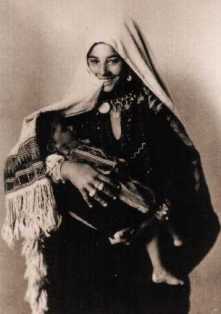
Wearing apparel in ancient times. Clothing was hand-woven and embroidered
- nerveless plants and crushed stone for dyes
- wove the fabric using portable looms
- grew and harvested flax for linen.
Their work was past no ways finished at this indicate. When the flax had been harvested they also
- dried the flax
- carded and spun the flax into either fine or coarse linen strips (linen produced by the Egyptians could exist woven finer than the fabric in a modern handkerchief).
- prepared dyes of various colors: bluish from wood, xanthous from pomegranate, lilac from myrtle, etc. Even the poorest Jewish women used vegetable dyes to go a range of colors for the family'due south woolen clothes. Flax did not take dye well.
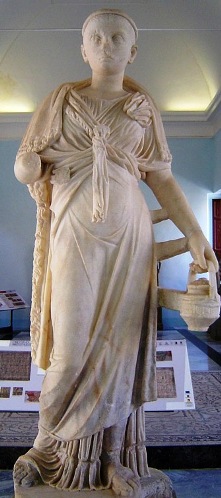
A 2nd century Roman priestess of Isis in a loose tunic and cloak, draped to exist practical and attractive
Design of clothing
The Bible covers a time span of several thousand years, but the type of clothing worn by near Jewish people during that time did not change much.
Jewish styles seem to take been influenced past both
- the simplicity of the Egyptians and
- the flamboyance of the Mesopotamians.
Jewish vesture was fringed, simply not like Mesopotamian wearable, which had fringes, overlapping material, frills, borders and colored braiding – less was non more than in ancient Mesopotamia… Run across archaeological evidence: ancient clothes.
A widow's article of clothing
Widows were apparently set apart by wearing special clothing.
How do we know this? In Genesis 38.14 there is the story of a feisty woman, Tamar, who was fighting for her rights. She ". . . put off her widow's garments, put on a veil, wrapped herself up, and saturday down at the entrance to Enaim . . ." She was trying to await similar a prostitute, then she could seduce her father-in-law Judah. When she had done so, she took off her veil and put on her widow's clothes again (Gen. 38.19).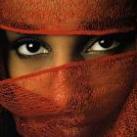
For this rather foreign story, see Tamar demands her rights.
There may have been similar garments worn by women who were in mourning. 2 Samuel 21.ten records that Rizpah, Saul's concubine, prepared sackcloth for herself to wear in mourning after her sons were handed over to the Gibeonites.
For this story, see Rizpah, female parent of murdered sons
'Although we cannot guess the color of a widow'south garments, it seems that they were made of rougher material than was typically used to make clothing.'
Women's Lives in Biblical Times, Jennie R. Ebeling, p.133
What were the items of clothing?
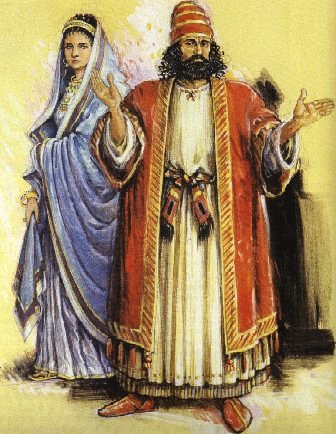
Apparel of the nobility, men'due south and women's, in ancient State of israel
Both women and men wore a loincloth, the equivalent of underpants. This was a long thin strip of material which was wound around the waist and and so betwixt the legs, with the end tucked in at the waist.
Women probably wore some sort of binding around their breasts.
The main garment, worn by both women and men, was the halug, a tunic. This was made of two rectangular pieces of cloth joined in a long seam forth the summit of the artillery, with a hole left for the head to go through. It also had a seam running downwardly both sides, with holes left for the arms.
The halug could be gathered up in a bunch at the shoulders, either with a clip or a tip-loop, or information technology could be tucked up at the waist if heavy piece of work was being done. Halugs made of fine linen or wool could be draped to fall gracefully.
The halug was worn with a belt, either leather or metal, the ornamentation depending on the wealth of the wearer.
A cloak could be worn over the halug. The edges and fringes of the cloak were often decorated.
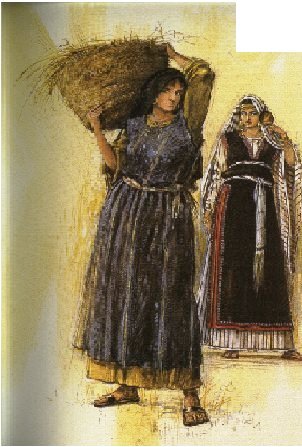
Jewish women had hard-wearing wearing apparel for daily life, and richly busy clothing (dyed and embroidered) for festivals
Note: 'An interesting ostracon (a piece of inscribed pottery) dating from the seventh century BC from the site of a fortress at Mesad Hashavyahu, well-nigh the coast of southern Israel, shows the value of clothing in ancient Israel. In this inscription, which was obviously dictated to a scribe, a field worker appeals to the governor of the fortress for the render of an item of wearable that he complains had been unjustly confiscated by a man named Hoshabyahu ben-Shobi. Although the detail of clothing is not specified, information technology was probably a mantle or cloak given its apparent worth to the worker.' Women's Lives in Biblical Times, Jennie R. Ebeling, T & T Clark International, p.93
When women went into public places, they wrapped their long hair in a piece of textile. This cloth held their pilus in place and acted as a head covering in the hot climate.
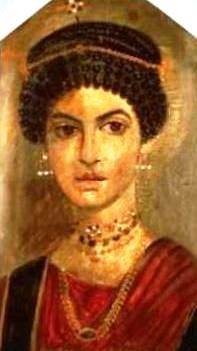
Hairstyle, jewelry and clothes of a wealthy 2nd century Advertisement woman; Fayum coffin portrait
It could besides be used equally a face covering. Rebecca used information technology to hide her confront when she kickoff met Isaac (Genesis 24:65). But she was non veiled when she was drawing water from the spring (Genesis 24:sixteen).
Total veiling, every bit worn by some Islamic women today, was not proficient. Sarah's beauty was manifestly visible to those around her (Genesis 12).
Aboriginal jewelry
Aboriginal people loved to decorate themselves with jewelry which, as today, was valued for its dazzler and for the status it gave to its owner. Every woman had jewelry of some kind, which was part of her personal wealth.
If it was part of her dowry, information technology would be worn clearly, especially on festival days when prospective suitors might be visiting the village – encounter the image of a young girl at the top of this page.
Jewelry is transportable wealth. It is besides an in-your-face condition symbol letting everyone know merely how rich you are. Women accept used jewels for thousands of years. Even Cro-Magnons had necklaces and bracelets.
For some wonderful pictures of aboriginal jewels, get to Jewellery in the ancient world
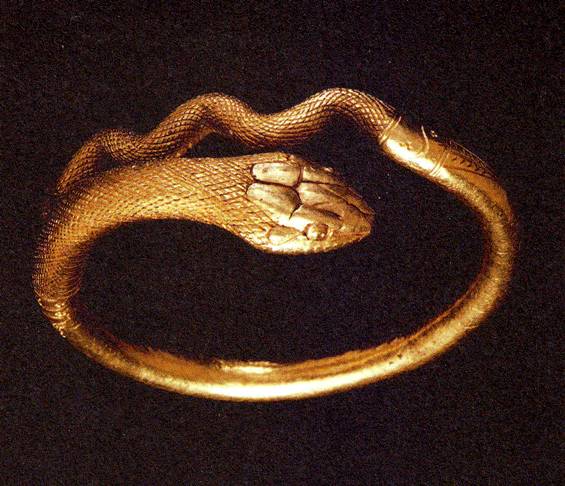
Golden bracelet in the form of a coiled snake,
1st century Advertizement, Roman, Pompeii.
Making the best of what you've got
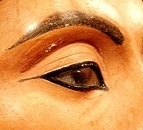 Rich and poor – cosmetics were used by women at all levels of lodge.
Rich and poor – cosmetics were used by women at all levels of lodge.
We know that women in aboriginal times
- manicured their nails
- tweezed superfluous pilus
- outlined their eyes in colors including black, greenish, aqua, terracotta and charcoal.
Brand-up, especially for the eyes, was popular.
Of course, there is no direct testify that women in ancient Israel wore make-upwardly, since in that location are no Israelite statues or images similar to the Egyptian ones we're familiar with.
But Israel was always influenced past its powerful neighbour to the southward, and it is reasonable to suppose that this influence also affected Hebrew/Israelite women.
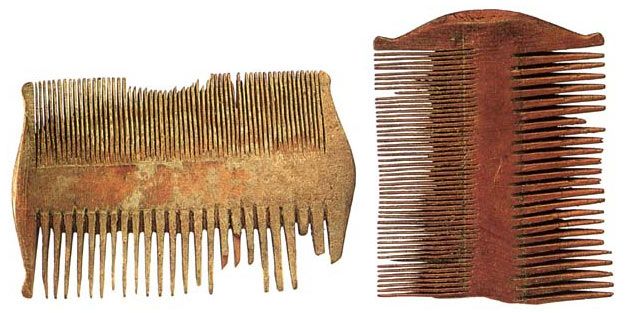
Above: 1st century wooden combs found at Qumran in the Judean Desert
Below: Women's hairpins of ivory and metal
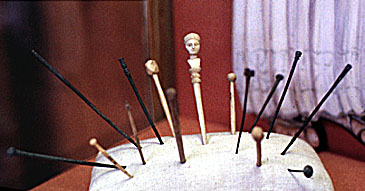
Archaeological evidence
We have a skilful thought of vesture in New Testament times because of a discovery fabricated in State of israel in 1960. Bedouin tribesmen establish many artifacts in a cavern well-nigh En-gedi on the Expressionless Sea, which were dated to the Bar Kokhba War in 132CE.
See Death at Masada, at the bottom of the webpage on Masada
Information technology appears that during the Bar Kokhba War a group of 17 people, including vi children, were trapped in the cave. They starved to decease there, rather than surrender to the Roman soldiers who were camped immediately higher up the entrance to their cave.
A range of textiles was constitute with their skeletons. At that place were women's cloaks, a child's linen shirt, and skeins and balls of unspun regal wool.
Laboratory analysis showed that three bones dyes had been used to obtain 34 different colors of thread (the three dyes were saffron yellow, indigo blue and alazarin red).
Amidst the artifacts found in the cavern were pieces of jewelry, a box for powder and a brass mirror in a wooden frame.
See The Ancient Middle E, Youtube video
Activities
Dressed for the Occasion
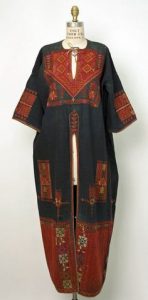 Using the information in this department or from the webpage below, design an outfit you might accept worn if you had lived in biblical times. You lot may use drawings or a written description to show the clothes you have chosen. Describe the cut, the material and the colour of each particular.
Using the information in this department or from the webpage below, design an outfit you might accept worn if you had lived in biblical times. You lot may use drawings or a written description to show the clothes you have chosen. Describe the cut, the material and the colour of each particular.
For more about clothing, try
Clothes in the ancient state of the Bible
Clothing for children in Bible times
Apparel for rich and poor in the aboriginal globe
Why practice we habiliment clothes? Clothes in the Bible
Nazareth people: what they wore
Search Box
![]()
Women of the Bible; Vesture and Houses in Biblical Times
Bible Written report Resources
0 Response to "Fashion Style of the Gibionites of the 21st Century"
Post a Comment